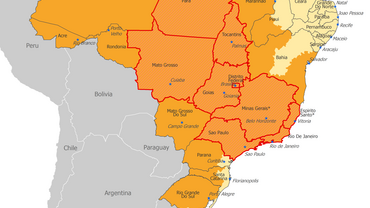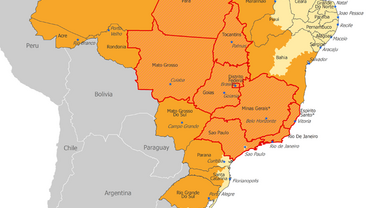Epidemiological update: Outbreak of yellow fever in Angola, 12 June 2016
An outbreak of yellow fever started in December 2015 in the municipality of Viana, Luanda province, and has since spread to all provinces of Angola.
An outbreak of yellow fever started in December 2015 in the municipality of Viana, Luanda province, and has since spread to all provinces of Angola. A rapid increase in the number of suspected cases has been recorded since mid-January 2016. As of 3 June 2016, the Angolan Ministry of Health has reported 2 954 cases and 328 deaths. These figures represent an increase of 687 cases and 35 deaths since the last epidemiological update on 8 May 2016. Of those cases, 819 are confirmed, including 482 from Luanda. Since 8 May, Luanda has reported 37 new confirmed cases. Confirmed cases have been reported in 16 of the 18 provinces in Angola while suspected cases have been reported in all provinces. Namibe province, which was newly affected at the beginning of May 2016, now reports two confirmed cases and ten suspected cases.
Yellow fever cases among travellers from Angola have been reported in China (11 cases), Democratic Republic of the Congo (56 confirmed cases) and Kenya (two cases). More than ten million people in Angola have been vaccinated through a large-scale campaign that has been running since the beginning of February. The vaccines have been mobilised through the yellow fever vaccine emergency stockpile that is made available through the International Coordinating Group for Vaccine Provision, with support from Gavi, the UN Central Emergency Response Fund, and a vaccine donation from Brazil. On 5 May 2016, the Ministry of Health of the Democratic Republic of the Congo (DRC) issued an update on the yellow fever outbreak. Since the beginning of January 2016 and as of 8 June 2016, DRC has reported 819 suspected cases and 56 laboratory-confirmed cases: 50 imported from Angola, reported in Kongo central province (35), Kinshasa province (10) and Kwango province (5). Two sylvatic autochthonous cases have been reported: one in Bas-Uele province and one in Tshuapa province since the beginning of the year. Additionally, four confirmed autochthonous cases have been reported in DRC: two in Kinshasa province, one in Kongo central province and one in Kwango province. This is an increase of two cases in the past week.
A response plan, involving the Ministry of Health, WHO and non-governmental organisations, has been implemented. On 8 June, authorities acknowledged the end of the mass vaccination campaign in 11 health zones in Kinsahsa and Kongo central provinces. According to the Ministry of Health, 2 007 998 people have been vaccinated while the target population was 1 977 734.
In Congo, on 2 June 2016 WHO reported one suspected case of yellow fever. The case has been identified in Bouenza department, bordering Cabinda province (Angola) and DRC. As of 9 June 2016, the laboratory confirmation is pending.
In Uganda, on 6 June 2016 UNICEF issued an update on the yellow fever outbreak in Uganda, which is unrelated to the outbreak in Angola. Between 26 March and 4 June 2016, health authorities reported 68 yellow fever cases, including seven deaths. Among them, seven cases including two deaths were laboratory-confirmed. The 68 cases are reported in Masaka, Rukungiri, Kalangala, Bukomasimbi, Kalungu, Lwengo, Lyantonde, Ntungamo and Rakai districts. None of the cases had a recent travel history to Angola.
On 1 June 2016, Ethiopian authorities reported a suspected yellow fever outbreak in South Ari woreda, in the region of South Omo (SNNPR province), Ethiopia. The first case was identified and reported on 13 May 2016. So far, five of the 22 suspected yellow fever cases have died, four in a facility and one in the community. The last case was reported on 18 May 2016. Cases are being treated in hospitals and a team of epidemiologists and microbiologists have been deployed to investigate and respond. Samples have been collected and are under investigation at national level.
The last reported yellow fever outbreak in Ethiopia occurred in 2013 and included 141 cases and 55 fatalities. The regions of Arbamich, Seguen and South Omo were affected by this outbreak.
On 6 June 2016, the media, quoting health authorities, reported that during the previous four weeks, the Ghana Health Service has received reports of four yellow fever cases from the Brong-Ahafo (3 cases) and Volta regions (1 case). The preliminary assessment is that the cases are confined to few communities and previous widespread vaccination in 2011 in those districts has provided most people with immunity against yellow fever.
Figure 1: Yellow fever cases distribution in Africa, week 1 to 24, 2016
AmericasOn 8 June 2016, Peruvian authorities reported 52 yellow fever cases in Peru since the beginning of the year. Most of these cases are reported from Junin department (35). However, one case is reported in the capital, Lima, and three in Cusco, a touristic area. This outbreak is not related to the current African outbreaks.
WHO estimates that 508 million people are living in 31 African countries at risk for transmission of yellow fever. Therefore, the large outbreak of yellow fever in Angola is of concern with regard to the risk of introduction of the virus through viraemic travellers to countries at risk of transmission, especially in neighbouring countries. In DRC, the confirmation of the autochthonous circulation in the capital is a major concern as Kinshasa is highly populated, representing a risk of extension to Brazzaville, the capital of Congo, that is located across the Congo river. ECDC published a rapid risk assessment on 25 March 2016 and an update on 30 May. The Aedes aegypti mosquito, a competent vector for yellow fever, is not present in continental Europe but is present on the island of Madeira, an autonomous region of Portugal. Proof of vaccination is required for all travellers aged nine months and above entering Angola and DRC. WHO recommends vaccination for all travellers older than 9 months of age in areas where there is evidence of persistent or periodic yellow fever virus transmission. European citizens travelling to, or residing in, Angola should be vaccinated against yellow fever as per their national health authorities’ recommendations. The vaccine should be administered at least 10 days before travelling. Yellow fever in an urban setting is considered a public health emergency that may result in a large number of cases. Vaccination is the single most important and effective measure for preventing yellow fever. Therefore, additional cases in unvaccinated populations related to this urban outbreak should be expected, until a sufficient proportion of the susceptible population is immunised. The outbreak in Angola, DRC and Uganda is not yet under control and is currently expanding to additional provinces, challenging the ongoing mass vaccination campaign with a potential vaccine shortage in the coming months. The control of the outbreak in the three countries is needed in order to prevent further spread in the region and beyond.







